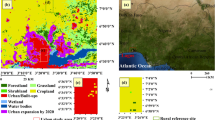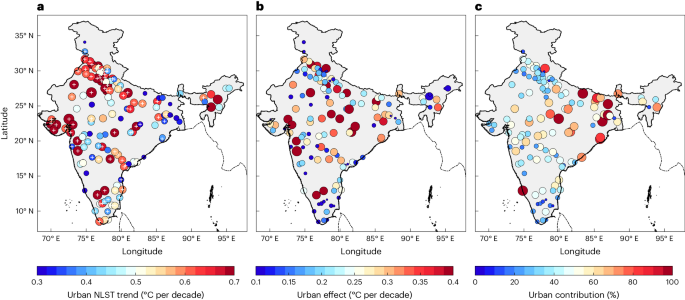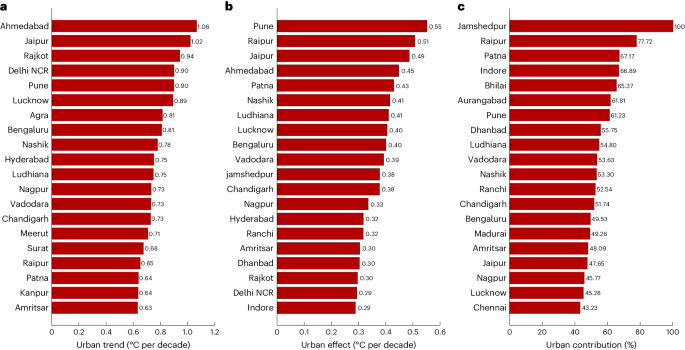
Cities are vulnerable to the compounding effects of both climate change and urbanization. Here we show that urbanization alone has led to an overall 60% enhancement in warming in Indian cities, with eastern Tier-II cities leading the way. Such a difference in the urban contribution to warming over cities across India calls for a differential approach to combat urban warming effectively.



Urbanization is one of the most visible and irreversible human interventions modifying land use and land cover, and it is a key driver of socioeconomic change. Despite accounting for only ~1% of the land, cities house more than half of the world’s inhabitants. Global forecasts indicate that the urban population share will reach 68% by 2050 1 . Despite being considered a sign of societal advancement, the ongoing unplanned and rapid urbanization—mostly in the developing world—has posed a substantial threat to the natural environment and caused a range of socioeconomic issues that risk the welfare of city dwellers.
In a warming climate threatened by anthropogenic climate change 2 , urban areas are highly vulnerable to the compounding effects of both urbanization and climate change. The changed urban landscape no longer benefits from evaporative cooling, but accumulates heat due to factors such as higher-thermal-inertia surfaces (for example, concrete and asphalt), modified convection efficiency and surface albedo, and enhanced anthropogenic activity, thus leading to the well-known urban heat island (UHI) effect, which subsequently affects other climate parameters (rainfall, pollution and so on) 3 . At the same time, urbanization and the associated energy demands lead to the production of greenhouse gases and associated emissions, contributing to climate change. Furthermore, due to the dense population and infrastructure of urban areas, they are on the frontlines of climate-change impacts such as heatwaves, extreme weather events and flooding 4,5 .
Indian cities are increasingly central to such discussions. With a projected doubling of the urban population by 2050 (reaching over 800 million urbanites), India is expected to witness the largest urban growth globally 1 . In addition, India is also projected to be the fastest-growing major economy in the world 6,7 , with the projected highest growth in energy demand by 2050 6 . To support this scale of expansion, substantial infrastructure development will occur, further deteriorating the emission scenario and affecting the local and regional climate. India is the seventh most profoundly impacted nation by climate-related extreme weather phenomena, according to the Global Climate Risk Index 2021 8 . Also, studies indicate that India will be one of the most vulnerable countries to the impact of climate change 5 , with its cities at the forefront 4 . Consequently, given the scale and scope of urbanization (both ongoing and projected) and exposure to climate-change-related risk, the synergistic effect of the two will make Indian cities particularly vulnerable.
Cities are both the harbingers of future climate change and one of the critical global systems that can speed up climate action 9 . Accordingly, for Indian cities, the timely consideration and strategic implementation of policies targeting climate resiliance are imperative. Although national urban missions (such as NMSH, Smart Cities, AMRUT and PMAY) are already underway and primarily focus on social and economic upliftment while targeting pressing local development needs, comprehensive city-level climate-action plans are the need of the hour 10 . To achieve this, more detailed studies on various facets of urbanization in India are needed to enable individual cities to develop tailored climate action plans to achieve the sustainable development goal (SDG) of ‘making cities inclusive, safe, resilient and sustainable’.
In this Brief Communication, we separate and quantify the impact of urbanization and the accompanying regional climate change on nighttime surface warming across multiple Indian cities, and we emphasize the need for systematic research into various aspects of urban climate.
Figure 1a presents the annual NLST trend for the period 2003–2020 across Indian cities. Almost all the cities across India were seen to have a positive NLST trend, with an overall mean rate of 0.53 ± 0.19 °C per decade over this period. It can be noted that the observed NLST warming is not limited to the cities. Indeed, most parts of India warmed during this period, with a mean rate of 0.26 ± 0.27 °C per decade. This indicates that cities are experiencing enhanced warming—almost double—relative to the entire Indian domain. Nevertheless, the warming trend documented throughout India is not homogeneous. Some areas, including the northwestern, northeastern and southern regions, are undergoing a comparatively more pronounced increase in NLST than in the other parts of the country (Supplementary Fig. 2). The same is also reflected in the NLST trend among cities spread across these regions. To further explore the details within the data, we looked at the background/regional warming for each city separately (Methods). A comparison of the trends in urban and background areas confirmed a positive correlation (r = 0.68, P < 0.01), indicating that regional climate change is driving some of the urban warming, as expected (Extended Data Fig. 1). However, the individual urban warming rate of most cities was found to be higher relative to their background warming rates.

The urbanization-driven warming (the urban effect) for each city is presented in Fig. 1b. The mean urban effect for all these cities across India was found to be 0.2 ± 0.15 °C per decade. This leads to an estimate of ~37.73% of the total urban warming being linked to urbanization—that is, ~60% enhancement of warming relative to the surrounding non-urban areas (Supplementary Fig. 3). The urban contribution of individual cities can reach as high as 100% in cities where regional tendencies are cooling but the city itself is showing a warming signature, thereby indicating complete urbanization-driven warming. The urban contribution is seen to be higher in cities in the eastern and central Indian regions, contrary to the cities showing the maximum urban trend (Fig. 1a). Cities showing a higher contribution are mostly developing cities that are undergoing rapid urban expansion, whereas in the cities showing a high urban trend this is the result of their location (that is, in regions of maximum climate warming). Figure 2 ranks the top 20 cities with populations of more than a million based on their urban warming trend (Fig. 2a), urban effect (Fig. 2b) and urban contribution to warming (Fig. 2c). Here, too, it is observed that the cities with the highest warming rates do not have the highest urban contribution to total warming. In light of this, it is clear that city-scale mitigation efforts to bring down their respective warming trends will not necessarily be effective for all cities. Urban planning-based mitigation measures will have a greater impact on cities with a larger urban contribution, whereas large-scale intervention will be necessary to reduce warming in cities dominated by regional effects. A detailed quantification of the urban contribution for all 141 cities is provided in Supplementary Table 1.

Furthermore, it is worth mentioning that sustainable city planning and adaptation strategies can be more readily implemented in developing cities, which also have the highest urban warming contribution. This is because these cities have more untapped natural resources at their disposal, which can be properly utilized if they act now, thereby steering their future growth trajectory towards a climate-resilient, sustainable city. This might not be true for developed cities, as they have mostly exhausted their available resources (for example, land use), leaving little room for city planning without reshaping or restructuring the existing infrastructure. Hence, the city action plan for sustainability has to follow a different approach for developed and developing cities.
In this study, cities are broadly classified with quantification driven by either local-scale urbanization or regional climate-change-related warming. Our study highlights the need for a diverse scale of mitigation efforts for an effective reduction in ongoing warming in Indian cities. The information provided in this study will help urban planners and policymakers better allocate resources and understand the scale of planning required for effective management of the urban thermal environment.
A total of 141 prominent cities in India were chosen for this study, and their city boundaries were demarcated using the urban class identified in the IGBP classification layer of the Terra and Aqua combined MODIS LULC data (MCD12Q1), and the satellite-imagery-based basemap layer available in ArcGIS. The two datasets were overlaid on each other in ArcGIS, then the boundary for each city was traced manually to create the final shape files. Whenever two or more cities were close, we merged them into a single boundary, considering it an urban agglomeration. A 20-km buffer was selected to delineate the surrounding non-urban region (Supplementary Fig. 4), and those pixels classified as urban were removed from this non-urban domain. Additionally, non-urban pixels not falling within ±50 m of the mean urban elevation were not considered. We used NASADEM elevation data for this purpose. We used MODIS Aqua NLST data (MYD11A2 v061) at 1-km spatial resolution from 2003 to 2020 to determine the annual NLST warming trend using two non-parametric methods: the Sen’s slope estimator and the Mann–Kendall test. This LST product is generated using the generalized split window algorithm and avoids cloudy pixels to prevent any potential interference with surface temperature 21 . Previous validation studies have reported the accuracy of this product to be better than 1 K (ref. 22 ).
We assume that the observed annual warming trend over the surrounding non-urban/rural region is primarily due to large-scale regional climate change, and the same for the urban region is due to the combined effect of warming driven by both regional climate change and local-scale changes due to urbanization. Therefore, the warming over the urban region has an additional urbanization-led part. So, urban-led warming can be segregated from total warming as follows:
$$>=<\frac<<\updelta T>_>->>><\left|<\updelta T>_>\right|>\times 100>$$where δTU and δTNU represent the change/trend in urban and surrounding non-urban region temperatures, respectively. Urban contribution values are restricted to a maximum of 100% and a minimum of 0%, considering urban contributions of cities above 100% and below 0% to be due to some unknown factors. Some of the potential limitations that may arise due to large-scale rural greening, the resolution of the data used, and the method adopted for urban–rural boundary delineation are briefly discussed in the Supplementary Information.Further information on research design is available in the Nature Portfolio Reporting Summary linked to this Article.
The data used in the current study are freely available in the public domain and can be downloaded from archives maintained by the Land Processes Distributed Active Archive Center (LP DAAC) of NASA (https://e4ftl01.cr.usgs.gov/). The basemap and city shape files used in the analysis are available from https://github.com/SSoumyaS/Shape_Files.
The analysis was carried out and the figures were generated using MATLAB R2022b (https://in.mathworks.com/products/matlab.html). These may be shared on reasonable request.
We acknowledge the MODIS mission scientists and principal investigators who provided the data used in this research effort. V.V. acknowledges support from the Department of Science and Technology Climate Change Program (DST-SPLICE) through project code DST/CCP/NUC/148/2018. S.S.S. acknowledges Council of Scientific & Industrial Research (CSIR) for providing a CSIR-NET fellowship (09/1059(0023)/2019-EMR-I) to carry out the doctoral research at IIT Bhubaneswar.